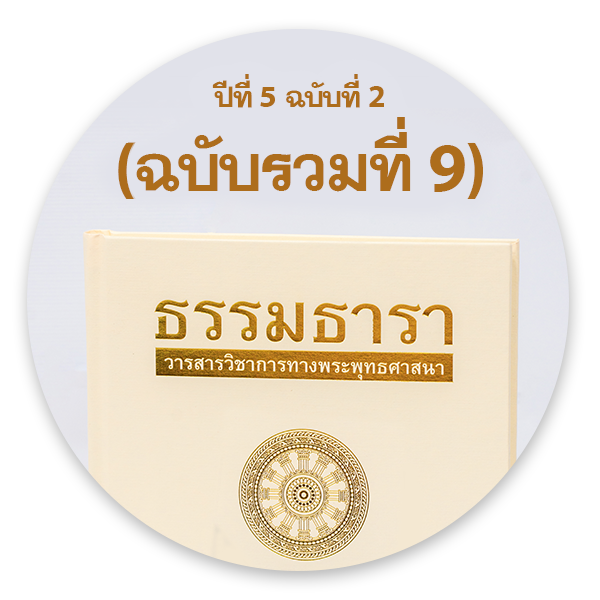คัมภีร์มิลินทปัญหา: ปริศนาเรื่องกำเนิดและพัฒนาการ
Main Article Content
บทคัดย่อ
คัมภีร์มิลินทปัญหาเป็นคัมภีร์ที่รวบรวมการถามและตอบปัญหาสำคัญในพระพุทธศาสนาเอาไว้เป็นจำนวนมากแต่ประเด็นที่มาของคัมภีร์มิลินทปัญหายังคงเป็นปริศนาให้ถกเถียงกันว่าเกิดขึ้นในยุคไหนและใครเป็นผู้แต่ง วัตถุประสงค์ในการศึกษาในบทความนี้มีคือศึกษาที่มาของคัมภีร์มิลินทปัญหา
ผลการศึกษาพบว่าแนวคิดการกำเนิดคัมภีร์มิลินทปัญหาถูกแบ่งออกเป็น 2 ช่วงใหญ่ ๆ คือ ช่วงที่ 1 เรียกว่า มิลินทปัญหากัณฑ์ต้น (กัณฑ์ที่ 1 -3) เชื่อว่าเกิดจาก 2 แนวคิดหลักคือ 1) แนวคิดที่สนับสนุนว่าคัมภีร์มีต้นกำเนิดมาจากวัฒนธรรมกรีกและรจนาด้วยภาษากรีก และ 2) กลุ่มที่สนับสนุนว่ามาจากวัฒนธรรมอินเดียและเชื่อว่าคัมภีร์ถูกรจนาด้วยภาษาท้องถิ่นคือภาษาปรากฤตหรือสันสกฤตในภูมิภาคตะวันตกเฉียงเหนือของอินเดีย ผู้เขียนสันนิษฐานว่าการที่รูปแบบและโครงสร้างของคัมภีร์มิลินทปัญหามีความคล้ายคลึงกับรูปแบบพิธีกรรมการสนทนาของอินเดียโบราณนั้น ได้เกิดขึ้นจากการผสมผสานระหว่างวัฒนธรรมอินเดียโบราณและวัฒนธรรมกรีกในยุคที่วัฒนธรรมกรีกรุ่งเรืองที่เรียกว่าวัฒนธรรมแบบเฮลเลนิสต์ ดังปรากฏคำศัพท์ เช่น Greco-Buddhism ซึ่งเป็นวัฒนธรรมที่ผสมผสานระหว่างวัฒนธรรมแบบเฮเลนิสต์และพระพุทธศาสนา ส่วนช่วงหลังหรือที่เรียกว่า คัมภีร์มิลินทปัญหากัณฑ์หลัง (กัณฑ์ที่ 4 – 7) โดยเฉพาะมิลินทปัญหากัณฑ์ที่ 4 รจนาขึ้นภายหลังในประเทศศรีลังกาเขตพื้นที่พระพุทธศาสนาแบบเถรวาท
Article Details
ลิขสิทธิ์ มูลนิธิสถาบันธรรมชัย ศูนย์พุทธศาสตร์ศึกษา DCI
เอกสารอ้างอิง
มหาจุฬาลงกรณราชวิทยาลัย. 2539. พระไตรปิฎกภาษาไทย ฉบับมหาจุฬาลงกรณราชวิทยาลัย. เล่มที่ 10. กรุงเทพมหานคร: มหาจุฬาลงกรณราชวิทยาลัย.
คณาจารย์มหาวิทยาลัยมหาจุฬาลงกรณราชวิทยาลัย. 2550. วรรณคดีบาลี. กรุงเทพมหานคร. มหาวิทยาลัยมหาจุฬาลงกรณราชวิทยาลัย.
ธนู แก้วโอภาส. มปป. ปรัชญา-ศาสนา ตะวันออก ตะวันตก. กรุงเทพมหานคร: สากลการศึกษา จำกัด.
นวพร เรืองสกุล. (แปล). 2558. มิลินทปัญหา: กษัตริย์กรีกถาม – พระเถระตอบ. กรุงเทพมหานคร: แปลจาก B. Pesala. 2001. The Debate of King Milinda. Middlesex: Association for insight meditation.
เนาวรัตน์ พันธ์วิไล. 2560. การวิเคราะห์บทสนทนาว่าด้วย ปัญหาอุภโตโกฏิ (ปัญหาสองเงื่อน) ในคัมภีร์มิลินทปัญหา. วิทยานิพนธ์ศิลปศาสตรมหาบัณฑิต สาขาปรัชญาและศาสนา. มหาวิทยาลัยเกษตรศาสตร์.
มหามกุฏราชวิทยาลัย. 2547. มิลินทปัญหาฉบับแปลในมหามกุฏราชวิทยาลัย. พิมพ์ครั้งที่ 3. กรุงเทพฯ: มหามกุฏราชวิทยาลัย.
พระพรหมคุณาภรณ์ (ป.อ. ปยุตฺโต). 2551. พจนานุกรมพุทธศาสน์ ฉบับประมวลศัพท์. พิมพ์ครั้งที่ 11. กรุงเทพมหานคร: เอส. อาร์. พริ้นติ้ง แมส โปรดักส์ จำกัด.
สมบัติ จันทรวงศ์. 2555. บทสนทนาของเพลโต: ยูไธโฟร อโพโลจี ไครโต. พิมพ์ครั้งที่ 3. กรุงเทพฯ: โครงการจัดพิมพ์คบไฟ
ซุนปิน. 2008. “ศัพท์จอมยุทธ์ภาษาจีนกลาง” www.baanjomyut.com/webboard/window_2/
August 17, 2019.
Mizuno, K.. 1996. "The Kind of Milindapanha." Research of Buddhist Texts (in Japanese) Tokyo : Shunjusha.
Müller, F.M.. 1965. The sacred books of the East. Delhi [India]: Motilal Banarsidass. อ้างใน มหามกุฏราชวิทยาลัย. 2547. มิลินทปัญหา. พิมพ์ครั้งที่ 3. กรุงเทพมหานคร: มหามกุฏราชวิทยาลัย.
Mori Sodo and Naniwa Senmyo. 1999. "King Milinda: The Greek who becomes a believer in the Buddhism." (in Japanese) Tokyo: Shimizushoin.
Rhys Davids. T. W.. 1890. The Questions of King Milinda, The sacred books of the East. Oxford : Claren Press.
Rapson, E. J. M.A. (rev. ed.) 1992. The Cambridge History of India, Vol.I. Cambridge : University Press.
Tarn, W.W.. 1938. The Greek in Bactia & India. Cambridge: Cambridge University Press.
Upasak. C.S.. 1990. History of Buddhism in Afghanistan. Central Institute of Higher Tibetan Studies, Sarnath, Varansi (U.P.) India.
Wheeler, R.E.M.. 1968. Flames Over Persepolis, Turning-point in History. London: Weidenfeld and Nicolson. อ้างใน Aston, G.V. 2004. Early India Logic and the Question of Greek influence. Doctor of Philosophy Thesis in Philosophy, University of Canterbury.
Wendland. P.. 1900. Aristeae ad Phlocratem Epistula. n.d. n.p. อ้างใน Tarn, W. W. 1938. The Greek in Bactia & India. Cambridge: Cambridge University Press.
Woodcock, G.. 1966. The Greeks in India. London: Faber and Faber. อ้างใน Aston, G.V. 2004. Early India Logic and the Question of Greek influence. Doctor of Philosophy Thesis in Philosophy, University of Canterbury.
Bakthin. M.M.. 1979. Problemy poetiki Dostoyevskogo (Problems of Dostoyevsky’s Poetics), 4th edition, Moscow, pp. 125 – 126, 152-153 อ้างใน Yaroslav, V. 1993. “Did East and West really meet in Milinda’s Questions?” The Petersburg Journal of Cultural Studies. Vol I, (1): 64 – 77.
Gonda, J.. 1949. “ Tarn's hypothesis on the origin of the Original of Milindapanha.”Mnemosyne, Fourth Series Vol. 2: pp. 44-62.
Guang, X.. 2007. “The Nāgasena Bhikṣu Sūtra An Annotated Translation from the Chinese Version” Journal of the Centre for Buddhist Studies, Sri Lanka. Vol. V. 113 – 216.
Guang, X.. 2008. “Introduction to the Nāgasena Bhikṣu Sūtra”. Journal of Buddhist Studies. Vol. VI : 235 – 251.
Guang, X.. 2009. “The Different Chinese Versions of the Nāgasena BhikṣuSūtra”. Journal of Buddhist Studies. Vol. VII : 226 – 247.
Mizuno, K.. 1959. “On the Recensions of Milindapaha”in Komazawa Daigaku kenkyu kiyo, (Summary of the Research Studies of University of Komazawa)], 17-55. Chinese Translation: 關於《彌蘭陀王問經》類,水野弘元《佛教文獻 研究》,許洋主譯,2003 年,頁221-292. อ้างใน X. Guang. 2008. “Introduction to the Nāgasena Bhikṣu Sūtra”. Journal of Buddhist Studies VI: 235 – 251.
Mizuno, K. 水野弘元. 1959. 〈ミリンダ問經類について〉 《駒澤大 学研究紀要》, Vol. 17, 17-55. (Mirinda-monkyo-rui ni tsuite) [“On the Recensions of Milindapañha”, Komazawa Daigaku kenkyu kiyo (Summary of the Research Studies of University of Komazawa)] Chinese translation :關於《 彌蘭陀王問經》 類 ,水野弘元《 佛教 文獻研究》 , 許洋主譯, 2003 年,頁 221-292. อ้างใน X. Guang. 2009. “The Different Chinese Versions of the Nāgasena
Bhikṣu Sūtra”. Journal of Buddhist Studies VII: 226 – 247.
Pachow, W.. 2000. “An Assessment of the Highlights in the Milindapanha.” Chung-Hwa Buddhist Journal, No.13.2, 1-27. Tarn, W. W. 1938. The Greek in Bactia & India. Cambridge: Cambridge University Press.
Rhys Davids. T. W. 1915. Milinda in Encyclopedia of Religion and Ethics, Ed.J Hastings, Vol. VII, Edinberge, J. Gonda. Tarn’s Hypothesis pp. 54 – 57. อ้างใน Yaroslav, V. 1993. “Did East and West really meet in Milinda’s Questions?” The Petersburg Journal Of Cultural Studies. Vol I, (1): 64 – 77.
Takakusu. J.. 1896. “Chinese Translations of the Milinda Paṇho” The Journal of the Royal Asiatic Society of Great Britain and Ireland. E-Journal of the Royal Asiatic Society of Great Britain and Ireland. : 1-21.
Tarn, W.W.. 1966. The Greek in Bactia & India. Cambridge: Cambridge University Press. cited in X. Guang. 2008. “Introduction to the Nāgasena Bhikṣu Sūtra”.Journal of Buddhist Studies VI: 235 – 251.
Sedlar, J.W.. 1980. India and the Greek World: A study in the transmission of culture. Totowa, New Jersey: Rowman and Littlefield. อ้างใน Aston, G.V. 2004. Early India Logic and the Question of Greek influence. Doctor of Philosophy Thesis in Philosophy, University of Canterbury.
Skilling, P.. 1998. A note on King Milinda in the Abhidharmakosabhaya. Journal of the Pali Text Society. 24, 81-101.
Winternitz M.. 1913. Geschichte der Indischen Litterateur, Vol. 2, Hf. I, Leiping, pp. 140 – 141.
Yaroslav, V.. 1993. “Did East and West really meet in Milinda’s Questions?” The Petersburg Journal of Cultural Studies. Vol I, (1): 64 – 77.
Antoine Simonin. 2011. “Euthydemid” Ancient History Encyclopedia (online) www.ancient.eu/euthydemid/, August 17, 2019.
Antoine Simonin. 2011. “Hellenistic_Period” Ancient History Encyclopedia (online) www.ancient.eu/Hellenistic_Period/, June 1, 2016.
Joshua J. Mark. 2018. “alexandria” Ancient History Encyclopedia (online) www.ancient.eu/alexandria/, August 17, 2019.
Marthal L. Carter. 1989. “BEGRĀM the site of ancient Kāpiśa, located 80.5 km north of Kabul overlooking the Panjšīr valley at the confluence of the Panjšīr and Ḡorband rivers.” Encyclopædia Iranica (online). www.iranicaonline.org/, August 17, 2019.
Schools Wikipedia Selection. 2007. Greco-Buddhism (Online). www.cs.mcgill.ca/, August 17, 2019.


